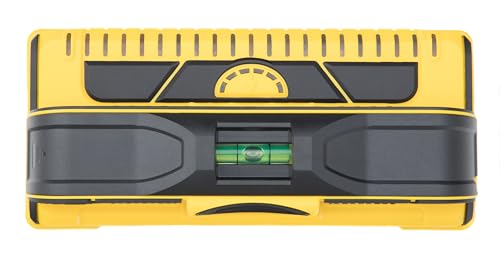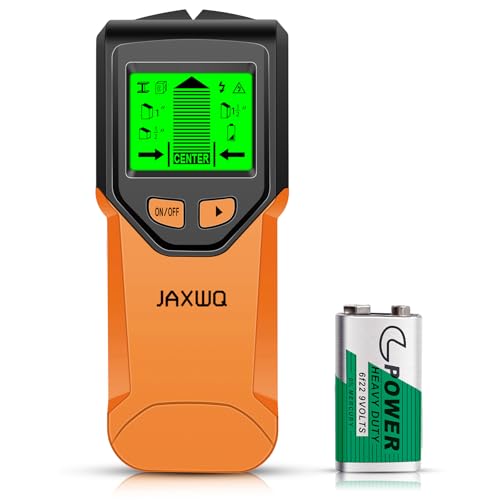Ever tried to hang a picture, shelf, or TV, only to realize you have no idea where the wall studs are hiding? It’s a common frustration! Without knowing where those sturdy supports are, you risk a wobbly mount or, even worse, a hole in your wall.
Choosing the right stud scanner can feel like a puzzle. So many types exist, and figuring out which one will actually work for you can be confusing. You want something reliable, easy to use, and that won’t break the bank. We get it!
That’s why we’ve put together this guide. By the end, you’ll understand the different kinds of stud scanners, what features really matter, and how to pick the perfect tool for your DIY projects. Get ready to hang things with confidence!
Our Top 5 Stud Scanner Recommendations at a Glance
Top 5 Stud Scanner Detailed Reviews
1. Franklin Sensors Prosensor M210 Stud Finder With 13-Sensors
Rating: 9.5/10
Tired of guessing where studs are hidden in your walls? The Franklin Sensors ProSensor M210 is here to help! This stud finder is built with advanced technology to make your DIY projects and home repairs much easier and safer. It’s made right here in the USA, so you know you’re getting a quality tool.
What We Like:
- It uses 13 patented sensors for super accurate stud finding.
- It has a built-in live wire meter to keep you safe while drilling.
- The wide LED screen shows you the whole stud, not just the middle.
- It automatically adjusts to find studs up to 1.7 inches deep, no matter the wall texture.
- It’s super durable and has been rated #1 by both regular folks and pros.
What Could Be Improved:
- Some users might find the initial setup a little tricky.
- It’s not the cheapest stud finder on the market.
The Franklin Sensors ProSensor M210 truly takes the guesswork out of wall scanning. It’s a reliable tool that prioritizes your safety and delivers accurate results every time.
2. Stud Finder Wall Scanner Detector – 5 in 1 Electronic Wall Wood Metal Stud Locator Edge Center Sensor Beam for Live AC Wire Pipe Metal Lumber Joist Drywall Framing Detection
Rating: 8.7/10
Tired of guessing where studs are behind your walls? The Stud Finder Wall Scanner Detector – 5 in 1 Electronic Wall Wood Metal Stud Locator is here to make your DIY projects and home repairs much easier and safer. This handy tool uses advanced sensors to quickly find the edges and centers of studs, pipes, and even live AC wires. It’s built tough and designed for anyone, from experienced pros to weekend warriors.
What We Like:
- Super Accurate: It finds studs and other things in walls with great precision.
- Finds Everything: It can locate wood studs, metal studs, pipes, and hot AC wires.
- Easy to Read Screen: A bright LCD screen shows you exactly where things are, and it has a backlight for dark rooms.
- Safety First: It warns you about live wires so you don’t accidentally drill into them.
- Built to Last: The scanner is made to handle bumps and dust, so it will last a long time.
- Simple to Use: Just turn it on and scan. It beeps to tell you when it finds something.
- Multiple Modes: It has different settings for finding wood, metal, or wires, up to different depths.
What Could Be Improved:
- Depth Limit: While it’s good for most walls, it might not detect super deep objects.
- Learning Curve: Some users might need a little practice to get the best results in different wall types.
This stud finder takes the guesswork out of hanging shelves or mounting TVs, and it helps keep you safe from hidden dangers. It’s a smart tool for any home.
3. Stud Finder Wall Scanner – 5 in 1 Stud Finder Tool w/Microprocessor Chip and HD LCD Display
Rating: 9.3/10
Tired of guessing where to drill? The Stud Finder Wall Scanner – 5 in 1 Stud Finder Tool w/Microprocessor Chip and HD LCD Display is here to make your DIY projects a breeze. This handy tool accurately finds studs, metal, pipes, and even live AC wires behind your walls, floors, and ceilings. It’s like having X-ray vision for your home!
What We Like:
- It’s super accurate and fast, thanks to its smart micro-sensor chip. You’ll save a lot of time and effort.
- The bright, backlit LCD screen clearly shows you where things are. It also beeps to guide you.
- It has different modes: stud scan, deep scan, and metal scan. This means it can find all sorts of things, even pipes and wires.
- It’s great for finding wood, metal, and AC wires in your house. This helps you avoid accidents when hanging things like TVs or shelves.
- This tool makes a unique and thoughtful gift for anyone who likes to do home improvements. It shows you care about their safety and efficiency.
What Could Be Improved:
- Sometimes, the instructions could be a little clearer for first-time users.
- While it’s great for most walls, very thick or unusual wall materials might require a slightly slower approach.
This stud finder is a real game-changer for any home improvement task. It brings safety and accuracy right to your fingertips.
4. Stud Finder Wall Scanner – 5 in 1 Stud Finder Tool w/Microprocessor Chip and HD LCD Display
Rating: 9.0/10
Tired of guessing where studs are behind your walls? The Lox 5-in-1 Stud Finder Wall Scanner takes the guesswork out of home improvement projects. This smart tool uses a special chip to quickly find the center and edges of studs, pipes, and even live wires hidden in your walls, floors, and ceilings. It’s like having a super-powered eye for what’s inside your home!
What We Like:
- It finds studs, metal, pipes, and live AC wires very accurately and fast.
- The bright LCD screen shows you exactly where things are, and it beeps to help you.
- It has different modes (stud, deep, and metal scan) so it can find all sorts of things.
- It’s a useful gift for anyone who likes to do DIY projects or wants to hang things safely.
- It helps you avoid accidents and saves you time and effort.
What Could Be Improved:
- Sometimes, very thin wires might be harder to detect.
- The beep sound could be a little louder for some users.
This stud finder is a fantastic tool for any homeowner or DIYer. It makes hanging shelves, TVs, and other items much safer and easier.
5. Walabot DIY 2 – Visual Stud Finder & Wall Scanner for Drywall. Detects Wood & Metal Studs
Rating: 8.9/10
Tired of guessing where to drill into your walls? The Walabot DIY 2 is a game-changer for any home improvement project. This smart device lets you see *inside* your walls, helping you find studs, pipes, and wires before you even touch a drill. It’s like having X-ray vision for your home!
What We Like:
- It shows you the exact center of wood or metal studs.
- You can easily track plastic and metal pipes.
- It detects both live and non-live electrical wires, keeping you safe.
- The visual display on your phone is much clearer than just hearing a beep.
- It connects directly to your phone via its own Wi-Fi, so you don’t need internet.
- It can scan up to 4 inches deep into your walls.
- It works with both iOS and Android phones.
What Could Be Improved:
- This scanner only works on drywall and plywood.
- It cannot be used on plaster, concrete, tiles, bricks, metal-backed walls, or stucco.
The Walabot DIY 2 makes home projects safer and easier. If you work with drywall, this tool will save you time and prevent costly mistakes.
Your Smart Guide to Finding the Best Stud Scanner
Hanging a picture, installing a shelf, or mounting a TV? You need to find studs! A stud scanner makes this job easy. It helps you find the wooden or metal beams inside your walls. This guide will help you pick the right one.
1. Key Features to Look For
Depth Detection
This tells you how deep the scanner can see into the wall. Most scanners can find studs up to 1 inch deep. Some can go deeper. If your walls are thick, look for a scanner with good depth detection.
Stud Type Detection
Some scanners can tell you if the stud is wood or metal. This is helpful. It lets you know what kind of screws you need.
AC Wire Detection
This is a very important safety feature. It warns you if there are live electrical wires behind the wall. Always look for this feature.
Display Screen
A clear screen makes it easy to read the results. Look for a screen that shows you the stud location and depth clearly. Some screens light up, which is great for dim rooms.
Audible Alerts
Many stud scanners beep when they find something. This makes it easy to know when you’ve found a stud. Some have adjustable volumes.
Center Finding
The best scanners will show you the exact center of the stud. This helps you drill right in the middle.
2. Important Materials
Stud scanners are usually made of strong plastic. This plastic should be durable. It needs to withstand being bumped around. The buttons should feel firm and easy to press. Some scanners have rubber grips. These make them easier to hold.
3. Factors That Improve or Reduce Quality
Accuracy
The most important thing is accuracy. A good scanner finds studs reliably. It shouldn’t give false readings. Cheaper scanners might be less accurate. Reading reviews can help you find accurate models.
Ease of Use
A good scanner is simple to use. You shouldn’t need a manual to figure it out. The markings on the screen should be easy to understand. A scanner that is hard to use will frustrate you.
Battery Life
Most scanners use batteries. Good battery life means you won’t have to change them often. Some scanners have low battery indicators.
Durability
A well-built scanner will last a long time. It should feel solid in your hand. Avoid scanners that feel flimsy or cheap.
4. User Experience and Use Cases
Using a stud scanner is usually straightforward. You turn it on and slide it across the wall. When it finds a stud, it will beep or show it on the screen. You might need to calibrate it first. This means pressing a button when it’s on a clear section of the wall.
Stud scanners are great for many tasks:
- Hanging heavy pictures or mirrors.
- Installing shelves or cabinets.
- Mounting your TV on the wall.
- Finding studs for DIY projects.
- Checking for wires before drilling.
A good stud scanner makes DIY projects much easier and safer. It helps you work with confidence.
Frequently Asked Questions (FAQ)
Q: What is a stud scanner?
A: A stud scanner is a tool that helps you find studs, which are the vertical beams inside your walls.
Q: Why do I need to find studs?
A: Studs provide strong support for hanging things on your walls, like shelves or TVs. They prevent your items from falling.
Q: How deep can stud scanners detect?
A: Most stud scanners can detect studs up to 1 inch deep. Some advanced models can go deeper.
Q: Can a stud scanner find metal studs?
A: Yes, many stud scanners can detect both wood and metal studs.
Q: Is AC wire detection important?
A: Yes, AC wire detection is a crucial safety feature that warns you of live electrical wires behind the wall.
Q: How do I use a stud scanner?
A: You typically turn it on, calibrate it on a clear wall section, and then slide it across the wall. It will alert you when it finds a stud.
Q: What does “calibration” mean for a stud scanner?
A: Calibration is the process of setting the scanner to recognize a clear wall section before it starts searching for studs.
Q: How accurate are stud scanners?
A: The accuracy of stud scanners can vary. Higher-quality models tend to be more reliable.
Q: Can I use a stud scanner on wallpaper?
A: Yes, you can usually use a stud scanner on wallpaper, but it’s best to test it first. Thick wallpaper might affect its readings.
Q: Where can I buy a stud scanner?
A: You can buy stud scanners at hardware stores, home improvement stores, and online retailers.
In conclusion, every product has unique features and benefits. We hope this review helps you decide if it meets your needs. An informed choice ensures the best experience.
If you have any questions or feedback, please share them in the comments. Your input helps everyone. Thank you for reading.

Hi, I’m Tom Scalisi, and welcome to The Saw Blog! I started this blog to share my hands-on experience and insights about woodworking tools—especially saws and saw blades. Over the years, I’ve had the chance to work with a wide range of tools, and I’m here to help both professionals and hobbyists make informed decisions when it comes to selecting and using their equipment. Whether you’re looking for in-depth reviews, tips, or just advice on how to get the best performance out of your tools, you’ll find it here. I’m excited to be part of your woodworking journey!





